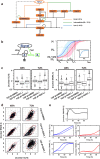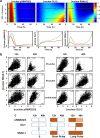Pathway crosstalk enables cells to interpret TGF-β duration
- PMID: 29872541
- PMCID: PMC5972147
- DOI: 10.1038/s41540-018-0060-5
Pathway crosstalk enables cells to interpret TGF-β duration
Abstract
The detection and transmission of the temporal quality of intracellular and extracellular signals is an essential cellular mechanism. It remains largely unexplored how cells interpret the duration information of a stimulus. In this paper, we performed an integrated quantitative and computational analysis on TGF-β induced activation of SNAIL1, a key transcription factor that regulates several subsequent cell fate decisions such as apoptosis and epithelial-to-mesenchymal transition. We demonstrate that crosstalk among multiple TGF-β activated pathways forms a relay from SMAD to GLI1 that initializes and maintains SNAILl expression, respectively. SNAIL1 functions as a key integrator of information from TGF-β signaling distributed through upstream divergent pathways. The intertwined network serves as a temporal checkpoint, so that cells can generate a transient or sustained expression of SNAIL1 depending on TGF-β duration. Furthermore, we observed that TGF-β treatment leads to an unexpected accumulation of GSK3 molecules in an enzymatically active tyrosine phosphorylation form in Golgi apparatus and ER, followed by accumulation of GSK3 molecules in an enzymatically inhibitive serine phosphorylation in the nucleus. Subsequent model analysis and inhibition experiments revealed that the initial localized increase of GSK3 enzymatic activity couples to the positive feedback loop of the substrate Gli1 to form a network motif with multi-objective functions. That is, the motif is robust against stochastic fluctuations, and has a narrow distribution of response time that is insensitive to initial conditions. Specifically for TGF-β signaling, the motif ensures a smooth relay from SMAD to GLI1 on regulating SNAIL1 expression.
Conflict of interest statement
The authors declare no competing interests.
Figures






Similar articles
-
A novel mechanism by which hepatocyte growth factor blocks tubular epithelial to mesenchymal transition.J Am Soc Nephrol. 2005 Jan;16(1):68-78. doi: 10.1681/ASN.2003090795. Epub 2004 Nov 10. J Am Soc Nephrol. 2005. PMID: 15537870
-
Inhibition of transforming growth factor-beta1-induced signaling and epithelial-to-mesenchymal transition by the Smad-binding peptide aptamer Trx-SARA.Mol Biol Cell. 2006 Sep;17(9):3819-31. doi: 10.1091/mbc.e05-10-0990. Epub 2006 Jun 14. Mol Biol Cell. 2006. PMID: 16775010 Free PMC article.
-
Transforming growth factor beta signaling via Ras in mesenchymal cells requires p21-activated kinase 2 for extracellular signal-regulated kinase-dependent transcriptional responses.Cancer Res. 2007 Apr 15;67(8):3673-82. doi: 10.1158/0008-5472.CAN-06-3211. Cancer Res. 2007. PMID: 17440079
-
Transforming growth factor-β signalling: role and consequences of Smad linker region phosphorylation.Cell Signal. 2013 Oct;25(10):2017-24. doi: 10.1016/j.cellsig.2013.06.001. Epub 2013 Jun 11. Cell Signal. 2013. PMID: 23770288 Review.
-
Crosstalk mechanisms between the mitogen-activated protein kinase pathways and Smad signaling downstream of TGF-beta: implications for carcinogenesis.Oncogene. 2005 Aug 29;24(37):5742-50. doi: 10.1038/sj.onc.1208928. Oncogene. 2005. PMID: 16123807 Review.
Cited by
-
Epithelial coxsackievirus adenovirus receptor promotes house dust mite-induced lung inflammation.Nat Commun. 2022 Oct 27;13(1):6407. doi: 10.1038/s41467-022-33882-w. Nat Commun. 2022. PMID: 36302767 Free PMC article.
-
Canonical BMP Signaling Executes Epithelial-Mesenchymal Transition Downstream of SNAIL1.Cancers (Basel). 2020 Apr 21;12(4):1019. doi: 10.3390/cancers12041019. Cancers (Basel). 2020. PMID: 32326239 Free PMC article.
-
Positive GLI1/INHBA feedback loop drives tumor progression in gastric cancer.Cancer Sci. 2024 Jul;115(7):2301-2317. doi: 10.1111/cas.16193. Epub 2024 Apr 27. Cancer Sci. 2024. PMID: 38676428 Free PMC article.
-
Bidirectional crosstalk between epithelial-mesenchymal plasticity and IFNγ-induced PD-L1 expression promotes tumour progression.R Soc Open Sci. 2022 Nov 2;9(11):220186. doi: 10.1098/rsos.220186. eCollection 2022 Nov. R Soc Open Sci. 2022. PMID: 36397970 Free PMC article.
-
Dynamic multi-omics and mechanistic modeling approach uncovers novel mechanisms of kidney fibrosis progression.Mol Syst Biol. 2025 Aug;21(8):1030-1065. doi: 10.1038/s44320-025-00116-2. Epub 2025 Jun 5. Mol Syst Biol. 2025. PMID: 40473842 Free PMC article.
References
Grants and funding
LinkOut - more resources
Full Text Sources
Other Literature Sources
Research Materials

